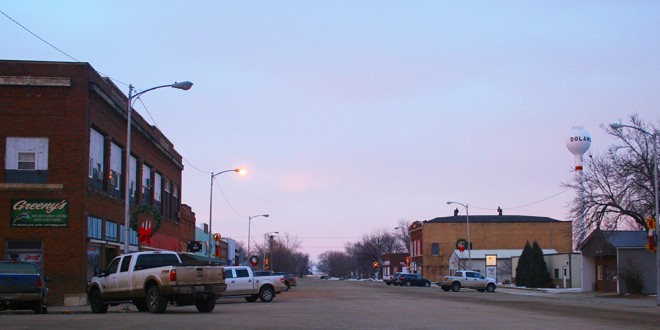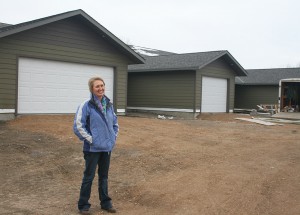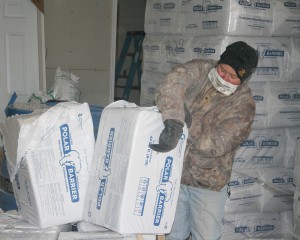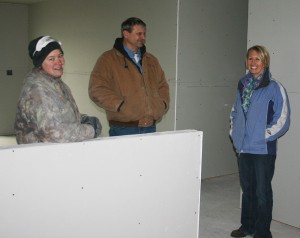By Wendy Royston, with photos by Heidi Marttila-Losure
In Doland, S.D., help is just around the corner.
“People like to help people here,” said Bonnie Wagner, a Doland High School graduate who now runs an insurance business in town, as she reminisced about a recent “harvest bee” in
which local farmers helped one of their own, who had been stricken ill. “If somebody needs help … we are gung-ho. It’s crazy how much is raised in one night at a benefit.”
Margot Gillette, who was born and raised in nearby Redfield, S.D., but now works at the Beadle-Spink Enterprise Community (BASEC) office in Doland, agreed.
“It’s really, really nice to watch when they all come together for whatever project is going on,” she said.
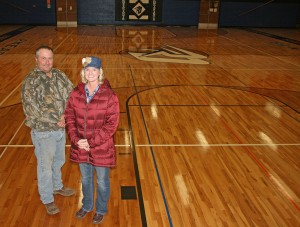
Doland school board members Dwight Lyren and Julie Schneider stand on the new gymnasium floor that was replaced with money raised in just a few days when the community was made aware of the need.
In 2012, the community of just over 200 raised more than $65,000 in a matter of a few days to refurbish the gym floor at its 103-year-old school when residents heard they might lose home games otherwise.
“There are a tremendous amount of people who live in this area who are committed to this community, and there are a lot of people who are from here, but no longer live here who are committed to this community, and it’s really nice to see them to come together for whatever project is going on,” Gillette said.
Whether it’s in reaction to an illness or tragedy, or proactive support of school or city projects, people in Doland put their money where their hearts are.
“You see it over and over and over again,” said Gillette. “It’s been a great five years in the ag economy, but even when belts are tight, when there’s a need, people will step up. … If you have more, you can give more, but that’s not the point. … Everybody has something to give.”
That spirit of giving is not surprising in a community where friends and neighbors and business associates and—yes, even family—are the same people.
“The farmers and homeowners are wonderful people,” said Wagner. “I don’t call them my customers. I call them my friends, because they are.”
Like many towns in northeastern South Dakota, “small” has been a way of life for generations.
“Doland has never had more than 500 people in it,” Gillette said. “It’s not like it started out as a town of 5,000 and it is now 200. … It never was that much bigger than around that 500 mark.”
The community has proved repeatedly that it is small but mighty, according to residents there. At a recent spaghetti feed, more than $20,000 was raised in just three hours to support a new, municipally-owned day care facility.
“My original thought was to make enough money on the fundraiser to build a basement,” Doland Mayor Craig Schroeder said. “And we did.”
Becoming more than a bedroom community
“We want young people to live here. You’re not going to get young people to live here if you don’t have a day care, because people work, and they need to have a place to take their kids for day care,” said Schroeder.
In order to be eligible for the Governor’s Daycare Program, the facility had to be city-owned, so Schroeder presented the idea to the council, which approved it before the full grant was secured for the roughly $90,000 project.
“Initially, I thought, ‘If we could get donations for the basement, (the city) would swing the rest,’” Schroeder said.
“The goal was to either eliminate or cause the … building of the facility to cost nothing,” Gillette said. “From what we can tell from other small town day cares, what puts them under is having to pay back that facility loan. … With the ups and downs of a day care … that has a significant impact, so if we could create a scenario where the facilities costs were eliminated… we didn’t have to worry about that, we got a good chunk of that taken care of with $20,000 in donations.”
Many of the day care’s needs—appliances, toys, furniture—were donated, and fundraising continues for the building.
The facility, which is slated to open in early 2015 is conveniently located across from the school.
“We really wanted it across from the school, so you could … pull up and pick everybody up,” Schroeder said.
Gillette pointed out that the day care-school relationship in Doland has a lot more significance than a common street, too.
Program expansion for growing school
Unlike most schools in the state, the Doland School District has actually grown over the past decade, from 163 students in K-12 in 2004 to 179 in this fall—nearly a 10 percent increase—and community leaders are hopeful that a need for more day care staff than originally anticipated will mean the school will grow, too.
“You can’t send your kid to preschool in town if you don’t have day care and you work somewhere else,” she said, pointing out that the nearest communities with preschools are 30 miles away, making it impossible for parents to transport their children to and fro in the middle of the workday.
It wasn’t until last school year that the school offered preschool, either.
“Kids are getting pushed a lot faster,” school board member Julie Schneider said. “We were afraid our kids might get behind.”
Plus, the board was concerned that kids who attended preschool might open-enroll permanently in those other districts.
“We were afraid of losing those kids,” Schneider said.
Dakota communities are well aware of the implications of declining enrollment, and know that every child enrolled is one more opportunity to keep the local school open. Twenty miles from Doland, the Conde school, which once co-oped with Doland for athletics, is an example of what can happen when a school’s enrollment falls too far. The school had attempted to run self-funded after the Legislature decided it would close schools with enrollments of under 100 or less in the late 2000s. Conde School was among those that closed.
“You always worry—if the school closes, what will happen” to local businesses and residents, said Wagner, remembering a not-too-distant time when closure of the Doland school was discussed. Shortly thereafter, enrollment increased as young men returned home to help with their fathers’ family farms. “I don’t think anybody even talks about that anymore, because the numbers are growing, and the funding seems to be going better, but that would be a challenge for a lot of us.”
Providing basic necessities for employees
In order for the school itself to function properly, it needs good leadership. And, in order to keep good help, the school needs good, affordable housing available to its staff. To ensure this is the case for its superintendent, the Doland School District has always provided a home as a benefit to its top official. By 2013, the most recent home, which was built in 1964, was showing its age.
“The house was in need of some repair, and it was (a question of whether we) stick money into an old house, or do we look at something that’s a lot more attractive and feasible,” said Schneider.
So the old house was sold to Doland Housing and Development, which rents the property out currently. With nothing in town available for sale that was as nice as the school wanted for its top employee, the school board took advantage of a governor’s house grant to bring in a new house and put it on a new basement, across from the school, in 2014.
“It’s hard to get a good superintendent to move to a small, rural town, but we can use this as a benefit,” school board member Dwight Lyren said.
A lack of suitable housing in Doland has been a deal-breaker for others looking to move to town, too.
Housing crunch hinders growth
Last summer, a Doland High School graduate was looking to move his family back to town, but had to change plans after reviewing the local housing market.
“He already had a job here. … When he got here, he found out the house he was going to rent was undesirable, because it had mold in the basement,” according to local business owner and farmer LeAnne Bawek. “He could not find anything to live in. … He ended up going to Redfield and getting another job and taking his kids and taking his employment. Gone.”
A similar situation arose when the school attempted to hire a new janitor. This kind of thing is a wakeup call, she said.
“We’ve seen small towns lose their schools. It’s the biggest employer. … That’s one of the biggest things that scares us,” Bawek said. “If we lose that school, how long before your town just slowly deteriorates?”
Bawek and a friend, Glenda McNutt, were working at a community blood drive in February 2014, when they began discussing the recent retirements of three Doland teachers, who were not looking to move out of town, and so no housing would become available for the teachers who would replace them. McNutt and Bawek perceived a major housing crisis in the community.
“Our housing stock is 100 years old,” said Bawek. “If it’s vacant, it’s not necessarily livable, or it’s a ‘hunter house.’ … The last house built was built in 1990,” and virtually no one is moving out of their homes.
In response to the impending need for teachers who likely could not find a place to live in Doland, McNutt and Bawek agreed “someone should do something” about the community’s housing crisis. They quickly realized that “someone” was them.

Beadle and Spink Enterprise Community has its office in Doland. From left is board president Craig Schroeder (also Doland’s mayor); Margot Gillette, executive director; and Amy Hofer, public relations and finance manager.
“When you decide that you’re going to take on a project here, you might as well figure you’re going to do it, because it’s not like somebody is going to jump up and (do it),” said Bawek. “Lack of people equals lack of time, and most people are focused on their families and businesses. … They don’t have the time to deal (with outside responsibilities).”
So, with the help of BASEC, the newly formed Local Opportunity Company started the process of applying for a grant to build a new, $400,000 triplex as the northeast “cornerstone” of Doland.
“It was kind of a Hail Mary type of thing, because who was going to give two gals in Doland, S.D., $100,000 to build a house?” Bawek said.
She completed her own housing study for the community, and highlighted Doland’s growing school and business community, as well as its up-and-coming day care, in the application.
“It’s all connected, and you need multiple parts of it to make it work. It wouldn’t work if we built the house and there wasn’t a day care and there weren’t jobs,” she said.
The hard work paid off, and the Local Opportunity Company received a $140,000 grant in May. Another $140,000 has been provided for the project through five private investors, and BASEC is supporting a more than $100,000 loan.
And it’s been full speed ahead ever since. McNutt and her husband have been hired by the Local Opportunity Company as the contractor for the project. The first unit is slated to open in January, and the other two should follow in February and March, according to Bawek. So far, none of the units is rented, although several members of the community have inquired about doing so.
Doland Housing and Development also has been working in recent years to clean up dilapidated houses, and is in the process of exploring the potential of “rehabbing” a run-down house in town, to get it back on the market.
Local leaders make Doland a poster town
So, what makes Doland tick? According to Gillette, it’s the people.
“The leadership in Doland is remarkable. You’re seeing it on the City Council and the school board and the citizens here,” said Gillette, adding that the community of Doland is a role model to other small towns across the Dakotas. “We work in seven communities, and it’s very important to BASEC that our other communities hear Doland’s success (because) we’re here to help them, too.”
And the community is working hard to ensure it will have another generation of leaders. Once each year, the adults and youths join forces to tackle a major community service project. The three adults and 10 youths on the board of the Doland Pride work together to plan each year’s project. Then, for one day, all students in seventh through 12th grades work together to accomplish that year’s project. Past projects have included painting all of Main Street’s buildings and cleaning up nuisance properties. That’s a lot of community service for roughly 64 students to tackle, but leaders in Doland say the benefits of working hard on the project are bigger than most for-pay jobs.
“It’s a good marketing tool to get them to aspire for the scholarships,” said Wagner. “It’s community work; it’s not 4-H, and it’s not sports or arts. A lot of us in the community look at … (their) attitude during Doland Pride” in determining the recipients of scholarships.
Identifying a need to move forward
But community progress wasn’t always the name of the game in Doland.
Schroeder became mayor about the time the bank that now houses BASEC closed, and the last new home built or brought into town was in the 1990s.
“I thought we needed to do things that (made) the city … a little more progressive and get things going,” he said. “Things were backing up really fast, and it scared me a little bit, so I thought we needed to get some things done.”
Gillette said that the biggest factor in Doland’s successes since Schroeder became mayor five years ago, has been an ongoing transition of leadership.
“Doland has always has had strong leaders in the development movement, but what we’re seeing in Doland now is a stepping up of younger people in the development movement,” she said. “That’s really an important element—that the baton of leadership and development be continued by the people who are carrying it now, and that we bring in new people in with new energy and new ideas. That’s what we’re seeing in Doland, and that’s why so many things are happening.”
 Dakotafire Get your spark here.
Dakotafire Get your spark here.


